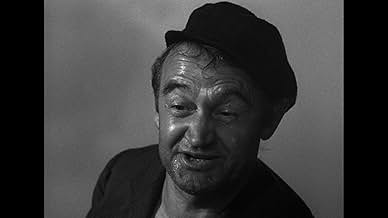VALUTAZIONE IMDb
7,5/10
4618
LA TUA VALUTAZIONE
Dopo essere stati ripescati da un marinaio, tre fuggitivi si ritrovano imprigionati nella nave di un brutale capitano che rifiuta di portarli a riva, costringendoli a escogitare un piano di ... Leggi tuttoDopo essere stati ripescati da un marinaio, tre fuggitivi si ritrovano imprigionati nella nave di un brutale capitano che rifiuta di portarli a riva, costringendoli a escogitare un piano di fuga durante un ammutinamento.Dopo essere stati ripescati da un marinaio, tre fuggitivi si ritrovano imprigionati nella nave di un brutale capitano che rifiuta di portarli a riva, costringendoli a escogitare un piano di fuga durante un ammutinamento.
- Candidato a 1 Oscar
- 2 candidature totali
Ernie Adams
- Pickpocket
- (non citato nei titoli originali)
Cliff Clark
- First Detective
- (non citato nei titoli originali)
Jeane Cowan
- Singer
- (non citato nei titoli originali)
Richard Cramer
- Bartender
- (non citato nei titoli originali)
William Gould
- Second Detective
- (non citato nei titoli originali)
Ralf Harolde
- Agent Getting Johnson Shanghaied
- (non citato nei titoli originali)
Oscar 'Dutch' Hendrian
- Crewman
- (non citato nei titoli originali)
Trama
Lo sapevi?
- QuizThe first movie to have its world premiere on a ship: the luxury liner "America", during a trip from San Francisco to Los Angeles.
- BlooperUntil the era of the 1st World War, the practice on board a ship was to call orders for the helmsman to move the tiller either to port or to starboard. Calling "hard a-port" meant moving the tiller to port, which means the rudder and the vessel, will then move to starboard. With wheel steering, putting the helm/tiller to port, means spinning the wheel to starboard. Ships no longer use this system - these days helm directions refer to the desired turn of the rudder/vessel. The James Cameron movie "Titanic" also contained a similar scene, which generated a lot of puzzlement. It IS a bit confusing at first, unless one is a sailor and is familiar with tiller steering.
- Citazioni
Humphrey Van Weyden: There's a price no man will pay for living.
- Versioni alternativeThe film was cut by approximately 12 minutes down to less than 90 minutes for re-issue. The deleted footage consisted of little, but integral, moments throughout the story which added considerably to the quality of the film as a whole. For many years, the only known existing print of the original 99-minute theatrical version was a 16mm print which belonged to the film's star, John Garfield. However, Warner Brothers studio recently discovered a 35mm print of this original version at the Museum of Modern Art in New York City. It was subsequently restored and used for distribution on DVD and Blu Ray.
- ConnessioniEdited into La nave fantasma (1993)
- Colonne sonoreHello! Ma Baby
(uncredited)
Music by Joseph E. Howard
Lyrics by Ida Emerson
Played on piano and sung by Jeane Cowan in the bar
Recensione in evidenza
"I've spit in the eye of better men than you for saying less", boatswain John Garfield snarls at sadistic captain Edward G. Robinson in this gritty film noir, set in the open sea, but fenced in, very noir-like, by constant dense fog.
I believe Raoul Walsh would have made a more dynamic film over Jack London's novel than Michael Curtiz did, but it is still a pretty good watch any day of the week. Robert Rossen wrote the screenplay which is well-structured, but far too literal and talkative for the pacing of a dramatic work of art. The lighting of the set, basically just the ship 'The Ghost', is brilliant, Erich Wolfgang Korngold's score must count among his best, highly effective and evocative.
Acting is on a very high level, with Robinson grabbing a first prize for his portrayal of the complex sadist 'Wolf' Larson. John Garfield is his swarthy and sexy adversary, and Barry Fitzgerald turns his signature role of the Irish leprechaun on its head with his vicious, diabolical snitch of a sailor, truly scary, a virtuoso performance.
I believe Raoul Walsh would have made a more dynamic film over Jack London's novel than Michael Curtiz did, but it is still a pretty good watch any day of the week. Robert Rossen wrote the screenplay which is well-structured, but far too literal and talkative for the pacing of a dramatic work of art. The lighting of the set, basically just the ship 'The Ghost', is brilliant, Erich Wolfgang Korngold's score must count among his best, highly effective and evocative.
Acting is on a very high level, with Robinson grabbing a first prize for his portrayal of the complex sadist 'Wolf' Larson. John Garfield is his swarthy and sexy adversary, and Barry Fitzgerald turns his signature role of the Irish leprechaun on its head with his vicious, diabolical snitch of a sailor, truly scary, a virtuoso performance.
I più visti
Accedi per valutare e creare un elenco di titoli salvati per ottenere consigli personalizzati
Dettagli
- Data di uscita
- Paese di origine
- Lingua
- Celebre anche come
- The Sea Wolf
- Luoghi delle riprese
- Azienda produttrice
- Vedi altri crediti dell’azienda su IMDbPro
Botteghino
- Budget
- 1.013.217 USD (previsto)
- Lordo in tutto il mondo
- 6.192 USD
- Tempo di esecuzione1 ora 40 minuti
- Colore
- Proporzioni
- 1.37 : 1
Contribuisci a questa pagina
Suggerisci una modifica o aggiungi i contenuti mancanti

Divario superiore
By what name was Il lupo dei mari (1941) officially released in India in English?
Rispondi

































